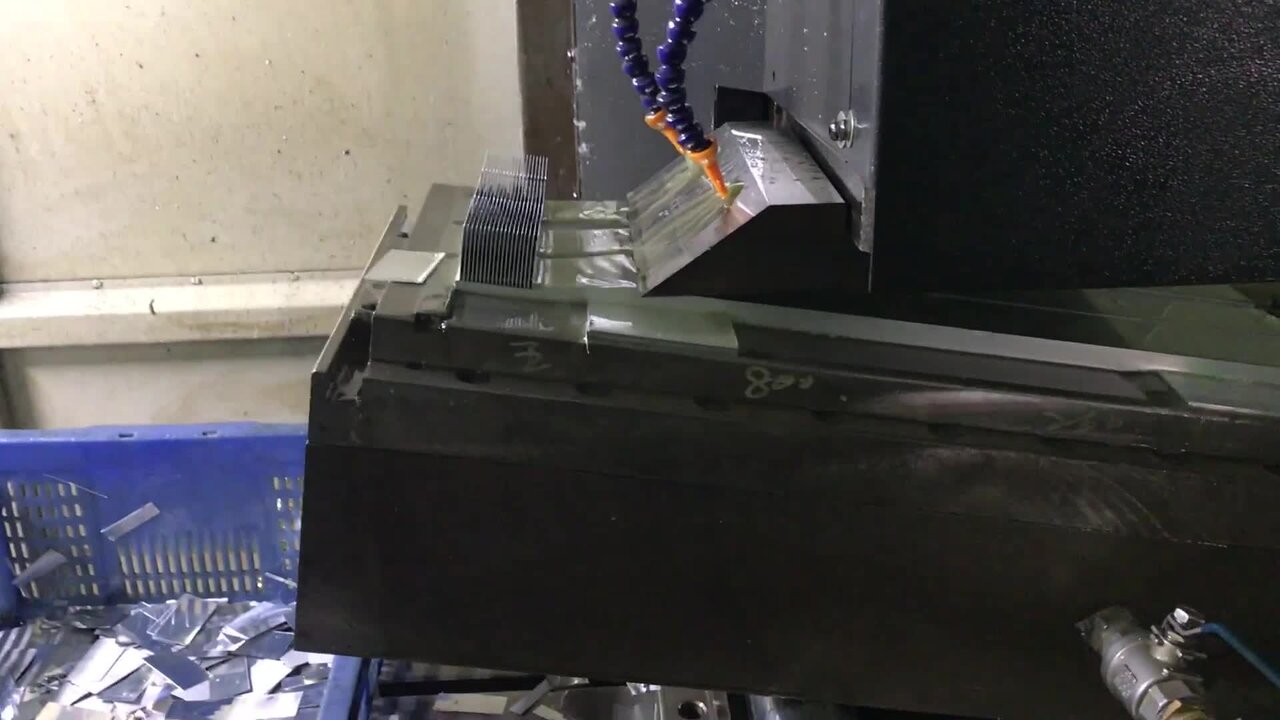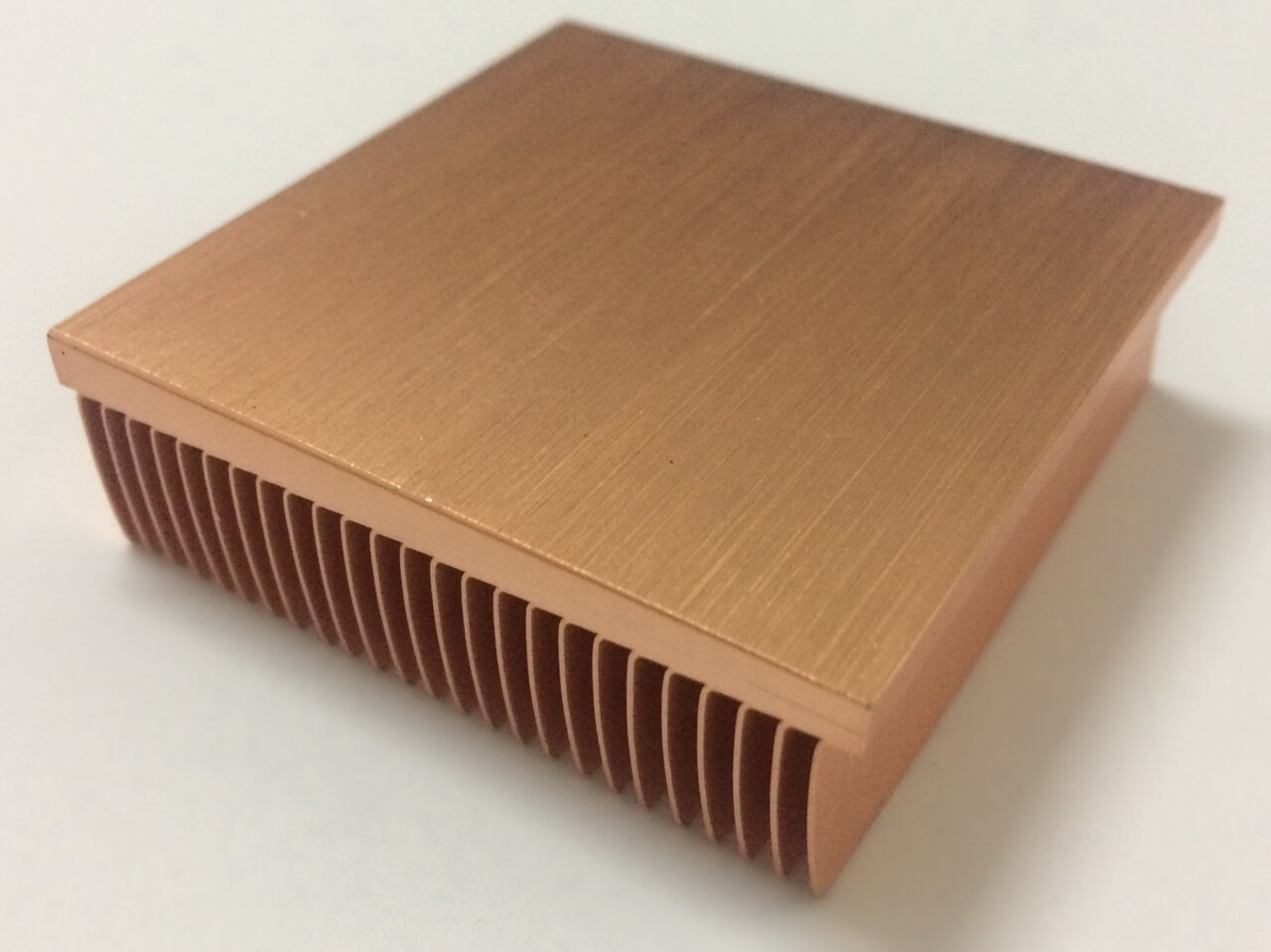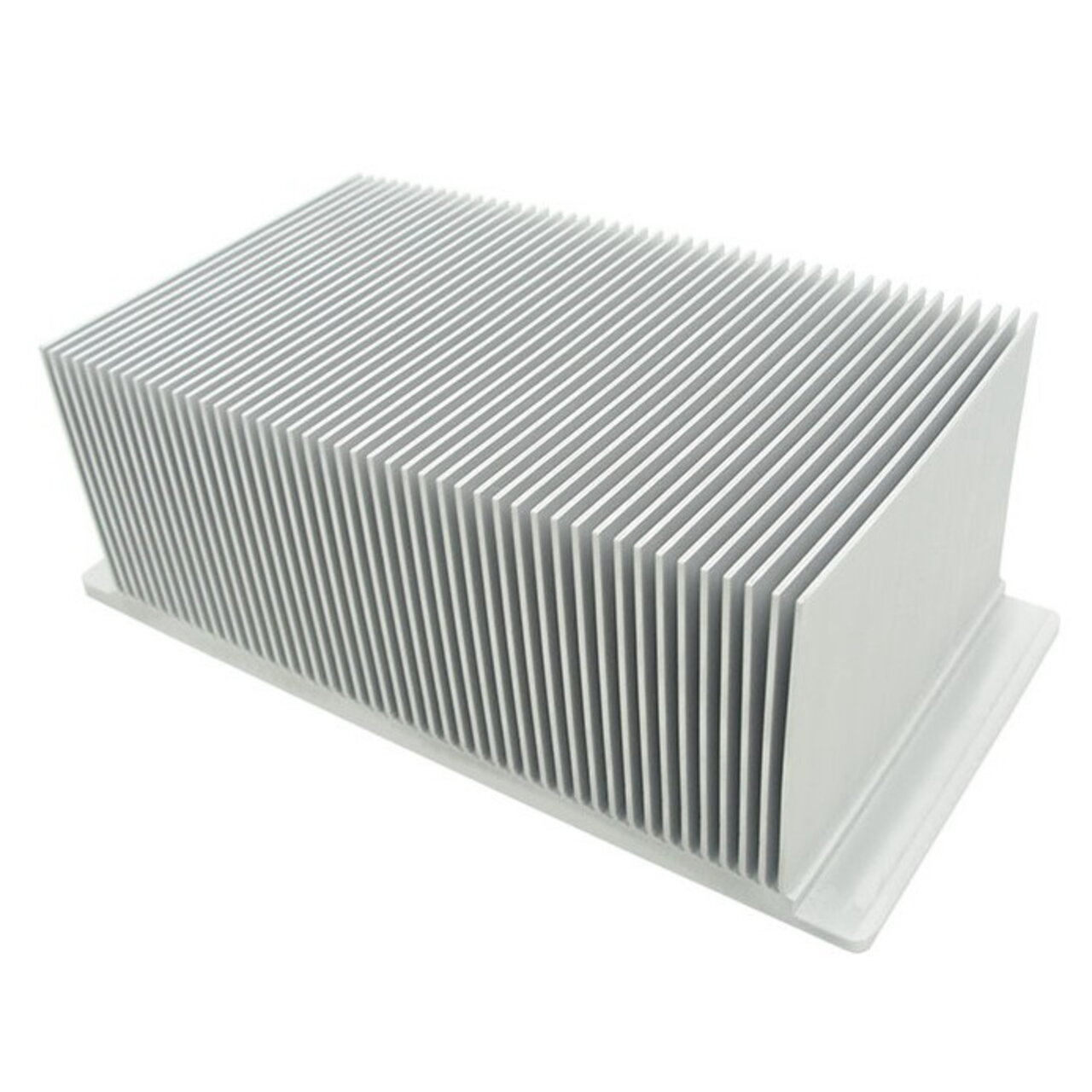High performance heat sink production machines
Heat Sink Skiving Machines built for Europe

Production of heat sinks
Which technology is the best to produce heat sinks?
Depending on their shapes and materials, heat sinks can be made by many manufacturing methods. The most common and cost effective methods include extrusion, forging, casting and stamping. Other methods to produce higher performing heat sinks include CNC machining, skiving and swaging. Although they are more expensive, they can produce high efficient and compact heat sinks with features that cannot be done by other methods. We concentrate on the best thermal solution in the smallest Volume: Fin skiving Technology.

Skived fin heat sink fabrication is a cutting-edge technology
Skived fin heat sink fabrication utilizes a different approach that slashes costs and speeds up production
Skived fin heat sink fabrication is a cutting-edge technology that offers significant cost savings and design flexibility compared to traditional extruded aluminum heat sinks. This innovative manufacturing process eliminates the need for expensive tooling, making prototyping more affordable and quick.
Traditionally, extruded aluminum heat sinks have been widely used in various industries such as automotive, aerospace, and electronics due to their excellent thermal conductivity. However, the manufacturing process of extruded aluminum heat sinks involves creating a custom die or tooling for each unique design. This not only adds to the overall cost but also increases lead times for production.
In contrast, skived fin heat sink fabrication utilizes a different approach that slashes costs and speeds up production. Instead of relying on costly tooling for each individual design variation, skived fin technology uses a single cutting tool to create each fin separately. This means lower tooling costs and faster turnaround times for prototyping.
In electronic components, there is a trend toward more power in less space.
However, this produces a negative side effect:
The higher power loss generates more heat that needs to be dissipated.
The large heat-conducting surface of skived fin heat sinks enables much faster and more efficient cooling of power electronics compared to normal heatsinks.
Skived fin heat sinks are made from raw metal block where fins are literally carved out of the heat sink base by a special blade tool.
The process begins with a flat block of high-quality aluminum or copper material that acts as the base substrate. The block is then precisely machined using computer-controlled equipment to create parallel channels on its surface. These channels serve as the foundation for the fins of the heat sink.
The next step involves using a specialized skiving machine or CNC milling machine equipped with diamond-tipped tools to cut thin fins from these parallel channels. The depth and angle of these cuts can be customized according to specific thermal requirements.
Since both fins and base are shaped from a single piece of raw metal block, skived fin heat sink are considered to be the best thermal conductivity between fins and base. Skiving method typically is used for aluminum and copper heat sink. Although it could be more costly than extrusion, skiving method is an ideal manufacturing method for prototyping and high performance applications and offers a superior heat dissipation.
One notable advantage of skived fin fabrication is its ability to produce fragile fins compared to extruded aluminum counterparts. Skived fins can be manufactured as thin as 0.1mm without compromising strength or structural integrity. This allows engineers more control over thermal management while reducing weight and maximizing airflow within compact electronic devices.
Furthermore, skiving technology enables intricate designs that are difficult or impossible to achieve through traditional methods like extrusion or stamping. Heat sinks with complex geometries featuring varying heights, widths, lengths, and distances between fins can be easily manufactured using skived fin fabrication.
The flexibility in design offered by skived fin technology is particularly beneficial for industries that require customized heat sinks to fit specific applications. For instance, the automotive industry often needs heat sinks tailored to fit into tight spaces within engine compartments or electronic control units. Skiving technology allows creating of compact, efficient, and high-performance heat sinks that meet these stringent requirements.
Another advantage of skived fin fabrication is its superior thermal performance compared to extruded aluminum counterparts. The precise machining process ensures excellent contact between the fins and the base substrate, optimizing heat transfer efficiency. This results in lower operating temperatures for electronic components, ultimately extending their lifespan and enhancing overall system reliability.
Due to their monolithic construction, skived fin heat sinks exhibit enhanced mechanical strength. Unlike extruded aluminum heat sinks susceptible to delamination or separation between fins and base substrates over time, skived fin designs offer a seamless interface without any weak points. This robust construction allows for improved durability even under harsh operating conditions.
Additionally, skiving technology enables manufacturers to utilize a wide range of materials apart from aluminum or copper for their heat sink fabrication needs. Materials such as stainless steel or alloys with higher thermal conductivity can be used if necessary for specialized applications where standard materials may not suffice.
Heat Sink Fin Skiving production explained on an old uncovered machines.
How do they make Skived Fin heat sinks?
Our fin skiving machines can skive fins from 50µm till 3 mm thickness
Our fin skiving machines can handle prototype making without tooling and moulding costs, serial production or unmanned continue production
Skived Fin Heat Sinks
Skived heat sinks can be constructed of aluminium or copper allowing for full, one-single-piece solutions without thermal barriers for high performance cooling.
Skived Fin Heat Sinks offerhighly optimized cooling as they allow for higher fin densities than what is manufacturable using extrusion methodologies, but do not have an interface joint that restricts heat flow like bonded or brazed fin heat sinks. Unlike bonded or brazed heat sinks, Skived Fin Heat Sinks are constructed from a single piece of material and offer reduced thermal resistance since there is no joint between a base and fins. These heat sinks are manufactured by precisely slicing the top of the base, called skiving, folding it back to where it is perpendicular to the base, and repeating at regular intervals to create fins.
The skiving process enables high fin density and thin fin heat sink geometries for optimal thermal performance. By packing as much fin surface area into a given volume, skived fin heat sinks have greater heat transfer than other single piece construction heat sinks such as extruded aluminum heat sinks. Compared to extruded aluminum, skived fin heat sink fabrication does not rely on expensive tooling, providing greater design flexibility and faster prototyping. Instead, each fin is cut separately using the same tool which allows for lower tooling costs.


Skived Heat Sinks tooling and production cost compared to other type of heat sinks production
Best ROI in High Performance Heat Sinks
Skived Heatsink Materials
Skived heatsinks are typically made from Copper or Aluminum, though other materials can also be used.
Aluminum
Aluminum is the most common material used in skived heatsinks. It is a good choice for applications where weight and size are important considerations, as aluminum is light yet strong. Additionally, aluminum has high thermal conductivity, meaning it can effectively remove heat from components. Skiving alters the thickness and smoothness of the aluminum sheet, which affects the heat sink's performance.
Copper
Copper is another common material used in skived heatsinks. Copper is another common material used in skived heatsinks. Compared to Aluminum, it has higher thermal conductivity, making it ideal for heat-intensive applications. Additionally, copper is corrosion-resistant and has a high melting point, making it a durable choice for long-term use. Skiving alters the thickness and smoothness of the copper sheet, which affects the heat sink's performance.

Benefits of a Skived fin Heat Sink
Performance of different types of heat sinks
Aluminium extruded and die cast heat sinks dominate the industry. As devises that require cooling becoming smaller and heat generation increases, companies are forced to look for a more efficient cooling solutions. One of them is SKIVED FIN heat sinks.
Comparing Skived fin heat sink design to bonded fins type assembly, Skived Fins will outperform by large margin due to bonded assembly. Thermal transfer is somewhat reduced by the bonding agent added thermal resistance. There are five common techniques that are used to manufacture heat sinks out of one piece:
- Die Casting
- Machining
- Extrusion
- Forging
- Skiving Fins
Thermal Conductivity
Diecasting is a method for manufacturing complex shapes in high volumes and low cost. Initial tooling cost outlay is high, but the parts cost during the production run is relatively low. Drawback is porous structure as the molten aluminium alloy cools in the die-set it expands creating voids. The porous structure weakens the part and adds to thermal resistance to the heat sink.
Extruded aluminium alloy heat sinks are most cost effective way for manufacturing linear shapes. The drawback is the limitation in the freedom in design, but this method requires low cost tooling. During the extrusion, alloy is heated below melting point and force-feed thru the forming die-set. However the grain structure cannot be controlled evenly and shape of the heatsink cannot be optimized completely thus somewhat reduce thermal performance.
Machined heat sinks: This way of producing is due to high CNC machining costs of machined heat sinks, economically feasible only for prototyping and special low volume and high cost products. Cost of production is limiting this heat sinks to prototype production.
Forging is the most effective method to produce complex shapes in high quantity and also offers interesting thermal advantages due to processing alloys at room temperature. Due to the nature of the forging process, part is formed at high pressure and low temperature, process that allow better control of the grain structure. Making heat sinks stronger and better conductors of heat. See here for more info on this subject.
Skiving fins is the latest technology, which is very promissing and grows exponential due to the many benefits: heat sink is formed out of one block with the highest cooling capacity per weight of material.
Skived Fin Heat Sinks offer highly optimized cooling as they allow for higher fin densities than what is manufacturable using extrusion methodologies, but do not have an interface joint that restricts heat flow like bonded or brazed fin heat sinks. Unlike bonded or brazed heat sinks, Skived Fin Heat Sinks are constructed from a single piece of material and offer reduced thermal resistance since there is no joint between a base and fins. These heat sinks are manufactured by precisely slicing the top of the base, called skiving, folding it back to where it is perpendicular to the base, and repeating at regular intervals to create fins.
The skiving process enables high fin density and thin fin heat sink geometries for optimal thermal performance. By packing as much fin surface area into a given volume, skived fin heat sinks have greater heat transfer than other single piece construction heat sinks such as extruded aluminum heat sinks. Compared to extruded aluminum, skived fin heat sink fabrication does not rely on expensive tooling, providing greater design flexibility and faster prototyping. Instead, each fin is cut separately using the same tool which allows for lower tooling costs.
Skived heat sinks can be constructed of aluminum or copper allowing for full, one-piece copper solutions for high performance cooling.
Heatsink Surface Area
Increased surface area of the heat sink will yield lower thermal resistance and better component cooling, but only if boundary layer is not formed and fins close proximity do not prohibit flow of air. When designing extruded part, fins must be tapered so that the aluminium alloy will pass through the tool without breaking it. The number of fins in an extrusion limited by strength of the die set and the size of the extrusion. These restrictions have negative impact on the surface area.
Skived fins require also no taper for extraction from the die casted moulding tool, allowing for more fins per given heat sink size. The Skived fin heat sink increases the surface area by 21% without increasing the size compared to casted parts. The result is improved thermal performance.
Reduced Cost
Depending on design, skived fin heat sink process can simplify manufacturing process. In cases when secondary operation required when working with extruded or die-cast heat sinks in skiving fins process this can be part of a single operation. That can greatly influence cost of the finished product. As the tooling cost is ZERO, this influence drastic the production cost!

Conclusion: Skived fin heat sink fabrication offers numerous advantages over traditional manufacturing processes.
In conclusion, skived fin heat sink fabrication offers numerous advantages over traditional extruded aluminum manufacturing processes. The absence of expensive tooling significantly reduces costs while providing greater design flexibility and faster prototyping capabilities. Skiving technology allows for the creation of thin fins with intricate geometries resulting in superior thermal performance and mechanical strength compared to extruded counterparts.
Skived fin heat sinks together with Forged heat sinks offer many advantages over machined, die cast and extruded processes.
The improved thermal performance due to aluminium grain structure coupled with the increased surface area without increasing the size of the heat sink and low process cost are main advantages. Skiving fins is also a very effective method for forming copper heat sink. Copper is difficult to extrude because it must be heated to high temperatures to soften the metal, making it challenging. Skiving is a cold process, and copper heat sinks can be formed with minimal waste.
Whether it's maximizing cooling efficiency in electronics or meeting specific requirements in various industries like automotive or aerospace, skived fin technology proves itself as a cost-effective solution with endless possibilities for customization and innovation in thermal management applications
Skiving by Wikipedia
Skiving or scarfing is the process of cutting material off in slices, usually metal, but also leather or laminates. Skiving is used instead of rolling the material to shape when the material must not be work hardened, or must not shed minute slivers of metal later which is common in cold rolling processes.
In metalworking, skiving can be used to remove a thin dimension of material or to create thin slices in an existing material, such as heat sinks where a large amount of surface area is required relative to the volume of the piece of metal.
The process involves moving the strip past precision-profiled slotted tools made to an exact shape, or past plain cutting tools. The tools are usually made of tungsten carbide-based compounds.
Skiving requires a minimum material feed rate to cut successfully. At speeds below those of metal planing or about 10 meters/minute (33 feet/minute), the skiving tools can be vibrated at high frequency to increase the relative speed between the tool and workpiece.
Heat sinks - Skiving machine producing copper heat sink fins.
Skiving is also used for the manufacturing of heat sinks for PC cooling products. A PC cooler created by skiving has the benefit that the heat sink base and fins are created from a single piece of material (copper or aluminum), providing improved heat dissipation and heat transfer from base to fins. Additionally, the skiving process also increases the roughness of the fins. Unlike the underside of a heat sink, which needs to be smooth for maximum contact area with the heat source, the fins benefit from this roughness because it increases the fins' surface area on which to dissipate heat into the air. The fins may be made much thinner and closer together than by extrusion or formed sheet processes, which can offer greater heat transfer in high-performance waterblocks for water cooling.
Skiving by Wikipedia
Fin skived heat sink, fin skiving, heat sink with skived fins, skived fin, skived fins, extruded heat sink, extruded heat sinks, extruded aluminum heatsink, bonded fin heat sink, aluminum heat sink extrusions, heat sink fins, extruded aluminum heatsinks, extruded aluminum heat sinks, extruded heat sinks with extruded fins, stamped heat sinks, skived fin, extruded heat sink profiles, heat sink machine, extruded heat sinks with fanned fins, aluminum vs copper heat sink, heat sinks manufacturers, thermal extruded heat sinks, aluminium heatsink extrusion, aluminum extrusion heat sink profiles, skived fin heat sink, stacked fin heat sink, copper vs. aluminum heatsinks, skiving heat sink, heat sink fabrication, bonded fin heat sink manufacturers, stamping heat sink, large heat sink extrusions, folded fin, forged heat sinks, copper vs aluminum heatsink, heat sink design, bonded fin heat sinks, heatsink extrusions, finned heat sink, stacked fin heat sink manufacturers, aluminum heatsink extrusions, aluminum extrusion heat sink, copper skived fin heat sink manufacturing, aluminium extrusion heat sink profiles, skived fin heat sinks, customized bonded fin heat sink, folded fin heat sink, copper skived fin heat sink manufacturers, aluminum extrusion heat sink profiles manufacturers, aluminum extrusion heat sink manufacturers, extruded heat sinks with vertical fins, skiving fin, skived heat sinks, bonded fin, stacked fin, extruded aluminum heat sink, skived fin heat sink manufacturers, skived fin heat sink factory, copper skived fin heat sink factory, extruded heat sink manufacturers, heatsink extrusion profiles, aluminum heat sink extrusion, copper skived fin heat sink, industrial heat sink, heatsink extrusion, stacked fin heat sink factory, aluminum heat sink fins manufacturers, skiving heatsink, skive fin heat sink, aluminum heat sink fins factory, folded fin heat sinks, zipper fin heat sink, heatsink extrusion profiles manufacturers, heat sink extrusion, skive fin heat sink manufacturers, skive fin heat sink suppliers, aluminum heat sink fins, aluminum heat sink suppliers, bonded heat sink, skived heatsink , copper or aluminum heatsink, skived heat sink , buy copper skived fin heat sink manufacturing, heat sink manufacturing process, high performance heat sink, heat sink extrusion profiles, aluminum heatsink extrusion, extrusion heat sink, what is skiving, skived, copper vs aluminium heatsink, extruded heat sinks manufacturers, fin heat sink, heat sink extrusions, skived fins, heatsink, aluminum heatsink extrusion profiles, extruded aluminum cooling fins, extruded aluminum heatsink manufacturer, heat sink manufacturing